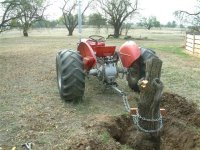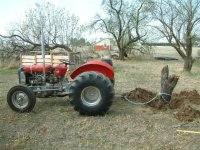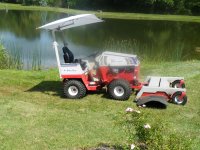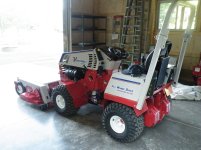woodlandfarms
Super Member
- Joined
- Jul 31, 2006
- Messages
- 6,118
- Location
- Los Angeles / SW Washington
- Tractor
- PowerTrac 1850, Kubota RTV x900
Try a Power Trac 425 or 1430. 30 degree slopes sideways (that is VERY steep)
This is a Ventrac video. As you notice they are going up and down which is just what a normal tractor would do. Why they didn't go sideways is a mystery, maybe the machine they say can, can't. But it gives you and idea of what 30 is. How Steep is 30 Degrees? - YouTube
I have a Power-Trac 1850 that is rated at 45 degrees sideways. Frankly I got off a 40 degree slope and pretty much tumbled down. Nearly had a heart attack getting back to the tractor. and getting in was no fun. 45 is really really really steep.
There are two other tractors (Ferrari and one other) that are true slope tractors but bring your gold card.
Widening the stance and adding fluid might get you 20 degrees sideways with a normal tractor. We looked very hard at "normal" tractors before we got the PT. Don't regret it but don't fault people keeping conventional machines either, quite jealous on occassion.
Versatile Tractors,Compact Tractors,Trailer Packages,Landscaping,Utility Vehicle Rentals,Mowers-Power Trac
This is a Ventrac video. As you notice they are going up and down which is just what a normal tractor would do. Why they didn't go sideways is a mystery, maybe the machine they say can, can't. But it gives you and idea of what 30 is. How Steep is 30 Degrees? - YouTube
I have a Power-Trac 1850 that is rated at 45 degrees sideways. Frankly I got off a 40 degree slope and pretty much tumbled down. Nearly had a heart attack getting back to the tractor. and getting in was no fun. 45 is really really really steep.
There are two other tractors (Ferrari and one other) that are true slope tractors but bring your gold card.
Widening the stance and adding fluid might get you 20 degrees sideways with a normal tractor. We looked very hard at "normal" tractors before we got the PT. Don't regret it but don't fault people keeping conventional machines either, quite jealous on occassion.
Versatile Tractors,Compact Tractors,Trailer Packages,Landscaping,Utility Vehicle Rentals,Mowers-Power Trac



